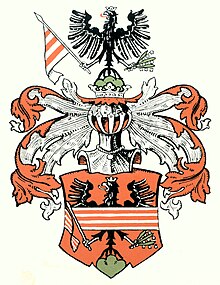Franz Ferdinand Mayer von Fahnenberg
Franz Ferdinand Mayer von Fahnenberg (born October 6, 1679 in Freiburg ; † October 2, 1741 in Freiburg) was a doctor of both rights and town clerk in Freiburg im Breisgau. In 1713 he saved the city from further destruction during the siege by a French army under Marshal Villars .
Life
Franz Ferdinand Mayer was born on October 6, 1679 as the son of Adam Melchior Mayer, lawyer and preceptor of the Breisgau knighthood and owner of the village of Föhrenthal (now part of Glottertal ) and Martha Elisabeth von Fantz. Franz Ferdinand studied law in Freiburg and received his doctorate in both rights ( Doctor iuris utriusque ), d. H. of secular (civil) law and canonical church law . As town clerk, Mayer was responsible for the administration of justice in Freiburg.
Siege of Freiburg in 1713
When the fortress commander Ferdinand Amadeus von Harrsch retreated into the Schlossberg fortress after several weeks of French siege with most of the other troops and the residents were therefore exposed to the immediate looting of the soldiers who had remained in the city and escaped prisoners of war, Franz Ferdinand Mayer hurried with them by the sculptor Norbert Wüst in the town hall to fetch the prepared white flags, went “to one of the bastions in the west of the city ... and planted the flags there.” As a result, city representatives were able to negotiate with the French commander Claude-Louis-Hector de Villars agreed a non-violent handover of the city and security from continued looting.
Honors and further life
Because of this courageous act, Emperor Charles VI. Dr. Franz Ferdinand Mayer to the knightly nobility in 1715 at the intercession of Harrsch. In Harrsch's letter of recommendation to the emperor of August 31, 1714, it says about Mayer: that he often does not go to me without risking life and limb, and when I demanded it appeared appropriate, soon pro bono Publico et Patriae that pardon Having made the breach, he conveyed in lieu of a considerable probation of his posh good experience and suitability to serve the public, also of his intrepidity, but primarily of his Austria. Faithful and all-underbelly devotion placed on the day, subsequent fame acquired by males in such a way that rewarding consideration is drawn, merit well . In the imperial nobility patent of February 27, 1715, Dr. Mayer with the bestowal of the honorary name of Fahnenberg bored to the right noble, coat of arms-fief-Turnir-comrade and knightly eight-shield nobleman raised .
The city of Freiburg made Mayer and his descendants hereditary honorary citizens.
By marrying the heiress Clara Katharina (1698–1780) of the Freiburg mayor Karl Heinrich Hornus von Bernkastel, Franz Ferdinand Mayer von Fahnenberg came into the possession of the city and lordship of Burkheim , with which income from the proceeds of the Rhine ferry and road tolls were connected. The document of July 15, 1744 reads: Emperor Karl VI awards the Dr. Franz Ferdinand Mayer von Fahnenberg as the bailiff and fiefdom of Klara Katharina, daughter of the late Karl Heinrich Hornus von Bernkastel, castle, town and rule of Burkheim as a fiefdom. Franz Ferdinand Mayer von Fahnenberg died of a stroke on October 2, 1741. His grandson was the Austrian Reichstag envoy Egid Joseph Karl von Fahnenberg (1749-1827), his great-grandson the Baden Oberpostdirektor Karl Heinrich Freiherr von Fahnenberg (1779-1840).
Varia
In historical reports Franz Ferdinand Mayer von Fahnenberg often bears the nickname of the savior of Freiburg . Near the former preacher's gate , where Dr. Mayer once jumped into the breach of the fortification with his white flag, the city of Freiburg named a square after the nobility title of its savior, Fahnenbergplatz.
literature
- Berthold Stöhr, Dr. Franz Ferdinand Mayer von Fahnenberg, brochure, 24 pages, Freiburg im Breisgau 1913
Individual evidence
- ^ Stöhr, page 13
- ^ Peter Kalchthaler: Freiburg ways . 1st edition. tape 2 . Rombach, Freiburg im Breisgau 1999, p. 64 .
- ^ Peter Kalchthaler: Small Freiburg city history . 1st edition. Friedrich Pustet, Regensburg 2006, p. 97 .
- ^ Stöhr, page 14
- ↑ Peter Paul Albert, Unprinted documents on the history of the siege of Freiburg in 1713, Alemannia Volume 30, page 223, 1903
- ^ Stöhr, page 13
- ^ History of the Mayer von Fahnenberg family, Freiburg city archive
Web links
| personal data | |
|---|---|
| SURNAME | Mayer von Fahnenberg, Franz Ferdinand |
| BRIEF DESCRIPTION | Town clerk |
| DATE OF BIRTH | October 6, 1679 |
| PLACE OF BIRTH | Freiburg |
| DATE OF DEATH | October 2, 1741 |
| Place of death | Freiburg |

